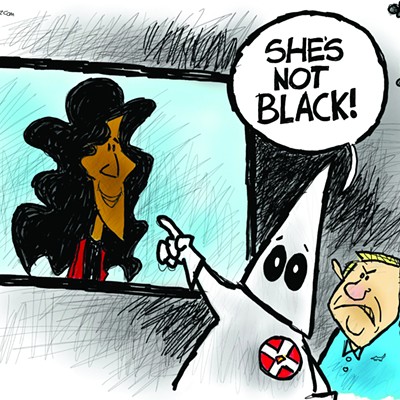Cranking his charismatic flair to charm reporters, Grijalva announced with great passion his opposition to a variety of things occurring in Amado, Arivaca, Elephant Head and Sopori--the quad specs in Pima's south end--as well as other rural villages from Ajo to Catalina.
Asked why he cared so greatly about matters far beyond the lines of his mostly urban district, Grijalva scorched the impertinent one with the fervor of an evangelical:
"The whole county is my district!"
And then some.
There is no surprise in Grijalva's subsequent attacks on Marana's greedy land grabs, but after 12 years in office the La Raza Unida member-turned-Democrat also has busied himself with telling Pinal County how its southern end should not sprout any more subdivisions and retirement villages.
Now in his second swing as chairman of the Board of Supervisors--a job he coveted so much that he made a hopeless run for it during his second term when the board was controlled by the GOP--Grijalva has positioned himself as the champion of Tohono O'odham members living in Mexico to gain U.S. citizenship. After a decade of neglect, he is the leader in the push for a county holiday honoring Cesar Chavez, the farm workers icon.
And he has the entire county bureaucracy sprinting to complete the Sonoran Desert Conservation Plan, the estimated half-billion-dollar land and habitat preservation plan.
"He is racing to get all this done. He is adding medal after medal, ribbon after ribbon all to properly suit up for Congress," says a lawyer who has represented clients before the Board of Supervisors through four decades.
"And it's his to lose," says the lawyer, who begged for anonymity for fear of reprisals ranging from a low-level zoning rejection to a loss of a routine contract.
Grijalva is trying his best to be coy. He wants to go to Congress, but he doesn't want to act like it.
Jovial after a recent board meeting, Grijalva insisted that he wanted to talk about next year's race for the new congressional district that absorbs his current county District 5, including Sam Hughes, West University, Jefferson Park, Blenman Elm, the Tucson Mountains and a nine-precinct panhandle of the south side, where he lives.
But he balked at any detail.
"Oh, you're killing me. You're killing me," he said.
Rattle off the names of wannabes, all Democrats: former Mayor Tom Volgy, perhaps the best candidate intellectually; former westside state Sen. Jaime Gutierrez, whom Grijalva scared out of the race for supervisor in 1988; state Sen. Elaine Richardson, a Gutierrez successor who has built alliances top to bottom in District 11; state Sen. Pete Rios of Dudleyville; and Fred Duval, a Tucson political wunderkind who was an aide in the Clinton White House.
To these Grijalva says, "Can we talk?" He does his usual pace. Sits down. Stands up. Rubs his face with both hands as if it were full of soap and he were at the sink. Reaches for a smoke, but can only play with the lighter.
"Oh, man! It's going to be interesting. Can we talk?"
But then he doesn't.
Add an incursion from the left, Jesus Romo-Vejar, a Tucson lawyer normally allied with Grijalva, and the waters that Grijalva was going to walk upon from Tucson through Sells and to Yuma become choppy.
Romo-Vejar, who not long ago emerged from a bankruptcy that was handled on a pro-bono basis by an attorney from politically-connected DeConcini McDonald Yetwin & Lacy, also benefited from Grijalva action, via then-County Manager Enrique Serna, to name his wife Isabel Garcia head of the county Legal Defender's Office in 1992.
The new district, in the configuration proposed by the state's Independent Redistricting Committee, broadens Grijalva's territory to go as far east at Craycroft Road between 22nd and 36th streets, to Wilmot Road in areas south of Valencia Road, the southwest including Pascua Yaqui and Tohono O'odham lands, the full span of the Tucson and Silver Bell mountains, and all the way to Ajo. It also takes in big portions of Pinal County, where Grijalva is preaching his land-use policy, and Yuma County.
It includes territory--such as the south and west sides, the Tohono O'odham Nation, Ajo and Yuma--that is now Congressional District 2. That longtime base of the late Morris K. Udall was won by Ed Pastor, a Phoenician who served on the Maricopa County Board of Supervisors. When Udall was forced by Parkinson's disease to retire in 1991, Pastor, with the help of Pima County Supervisor Dan Eckstrom, defeated Volgy in a special election.
A professor of political science at the UA and author of a number of well-received books, Volgy tried unsuccessfully for Congress again in 1998 in District 5, held by Republican Jim Kolbe since 1984. Volgy did well against Kolbe in the area that overlaps Grijalva's district and that is now in the new congressional district, losing just one precinct to Kolbe, a sparsely populated one west of the Santa Cruz River and north of Sunset Road.
Unlike Volgy, Grijalva has never lost. He swept through three elections, including one while a member of La Raza Unida. But rather than regarding that victory a source of pride for him and that party, Grijalva buries it, preferring to credential himself as a "lifelong" Democrat. He left the TUSD board in 1986 and toyed with the idea of being the first Mexican-American mayor in generations two years ago, before letting Molly McKasson run, and lose, to Republican Bob Walkup.
Pastor now will be safely ensconced in a Maricopa district, while the new Pima County and Southern Arizona district--stamped "G" on Redistricting Committee maps--seems tailor-made for Grijalva.
NEVER SERIOUSLY CHALLENGED at the polls, Grijalva has ridden a wave of popularity in his district. It is about 45 percent Hispanic and filled out with what political commentator and strategist Emil Franzi calls precincts of "white liberal guilt" voters. They love Grijalva. They love that they vote for a Mexican-American. They love his votes to deny any building in the Tucson and Tortolita mountains. They love how he dupes developers and their consultants and lawyers sucking down their campaign cash and then voting no, no, no. They love the Sonoran Desert Conservation Plan. They don't mind that he flouts the county no-smoking law or the laws that he helped initiate, including one that bars interference by supervisors in daily county management and another that bars firms from doing business with the county if they are in any legal trouble. They don't mind paying taxes, the highest for property taxes of any Arizona county. They don't mind the big debts he and the Board of Supervisors ran up--hitting $60 million three years ago--to force those high taxes. They don't mind that Kino Community Hospital, which replaced the old Pima County General 17 years ago, is faltering under turnstile management and an accreditation survey that nearly forced its closure earlier this year.
And they don't mind Grijalva's sales tax schemes. He is much like former mayor George Miller, a Democrat who consistently pushed half-cent sales taxes for road and transportation plans. Voters killed the proposals twice, but supported Miller for City Council and for mayor. Another Grijalva-backed sales tax, a penny on every four dollars for jails and juvenile detention, was crushed by voters in 1994. Voters throughout Grijalva's district torpedoed each sales tax, yet he has pushed for a general county sales tax of a half-cent per dollar ever since Pima County received legislative authority to implement one with just a unanimous vote of the Board of Supervisors.
Grijalva won't be alone as he looks for love in the new Congressional district that, with a population today of 641,392, is minority-majority with nearly 51 percent Hispanic and nearly 6 percent Native American. He has Sharon Bronson, the two-term Democratic supervisor whose District 3 stretches from the northwest and southwest sides to Ajo. If her handlers, David Steele and Matt Smith of the Strategic Issues Management Group, climb aboard, Grijalva might breeze through the Tohono O'odham Nation. That is where they hit hidden jackpots of votes to rescue Bronson, who needed every one of them to slip past Republican Barney Brenner last year.
But Grijalva has another weapon in Sells and other Tohono O'odham villages. His longtime ally Margo Cowan, an old-line lefty protester, is a tribal adviser who has orchestrated much of the drive to get citizenship for tribal members living in Mexico.
Another old ally is absent--or worse, in a rival camp. Alonzo Morado, once a quiet, selfless aide to Volgy, is with Gutierrez. Morado, a former mid-level but high-profile executive with Wells Fargo Bank, is married to Lorraine Lee, a Grijalva supporter and a vice president of Chicanos por la Causa.
"They're friends," Grijalva says to explain why Morado is working for Gutierrez.
In political reality, Gutierrez is beyond yesterday's news, a has-been who has been out of office since 1992. That is the year he left the state Senate and planned to boost his retirement with a cake-walk election as Justice of the Peace. But the Gutierrez machine, under longtime consultant and strategist Jan Lesher, sputtered. Embarrassingly, he failed to even collect the requisite nominating signatures. After contemplating life as a burger-flipper with his own McDonald's franchise, he landed on a high perch and $96,000 a year as a vice president for community relations at the UA.
Blessed with good looks, Gutierrez is being aided by powerful Hispanics that insiders know as the "Brown Capitalists." He's tried to raise his profile with work as chair of the citizens committee picked by the police to review the police mishandling of the North Fourth Avenue riot the night the UA lost to Duke in the NCAA basketball championship.
Volgy is the only one who has campaigned through most of the district, although it was a decade ago. He was mayor then and spent a lot of that shortened campaign in Yuma, to which he frugally drove.
But Grijalva has Ruben Reyes for Yuma duty. Perhaps better known for his En Vivo performances on local television, Reyes has served as a Grijalva driver and understudy to top Grijalva aide Glenn Miller, who has been allowed to wield more power than a majority of supervisors. Reyes is from the Yuma area and can sew up support for his boss. It is key, however, that Grijalva get the Cesar Chavez holiday passed. Chavez also was a Yuma-area native.
Grijalva has one constraint. Arizona law will force him to resign from the Board of Supervisors to run for Congress. It is something he will do only with great trepidation. Then his former colleagues will chose his replacement. That list includes Reyes and activist Salomon R. Baldenegro, who once thought Grijalva was too tight with white school board members.
FRANZI, WHO PACKS political hits from work in Arizona, Southern California and Chicago, says it all may come down to the crowd.
Volgy has strength, Franzi says.
But load the contest with Mexican-Americans and "a Bubba from Yuma wins it," Franzi adds.
And there is a "Bubba" from Yuma.
He is Ross Hieb, a retired Marine colonel, member of the Yuma City Council, chairman of the Yuma Metropolitan Planning Organization, and a seemingly perfect alternative.
With one exception. Hieb is a Republican.
Democrats command a 56-percent to 26-percent advantage in registration over Republicans. Another 28,228 are unaffiliated. The district, as drawn now, has 228,492 voters.
Redistricting, by virtue of voter approval last year of Proposition 106, is being done by an appointed committee of five. It is chaired by Steve Lynn, a registered Independent who worked on the successful Democratic campaigns of Mayor Miller in 1991 and 1995 and on the losing supervisorial campaign of Republican Lee Davis in 1992.
The second round of public meetings on the maps ends Saturday, September 15. The commission will then begin final work on the congressional and legislative maps that also must be cleared under the U.S. Voting Rights Act for effect on minority voters.












